Used spark plugs show different forms, colors, deposits, and textures. Each feature says something about the spark plug as well as the engine condition. All we need to do is identify these features and address them to improve the vehicle’s condition.
So, how to read a spark plug? What do different deposits, colors, and textures mean?
Here are different spark plug characteristics and what they mean for the spark plug:
- Oil fouling: black and wet deposits, greasy in texture.
- Carbon fouling: black and dry deposits, sooty in texture.
- Ash deposits: white crusty deposits, dry and sandy in texture.
- Worn-out spark plug: the center electrode is worn out and can be hardly seen.
- Normal spark plug: no deposits, slight discoloration.
Let’s dig deeper into each of these cases and discuss their causes and remedies.
#1: Oil Fouling
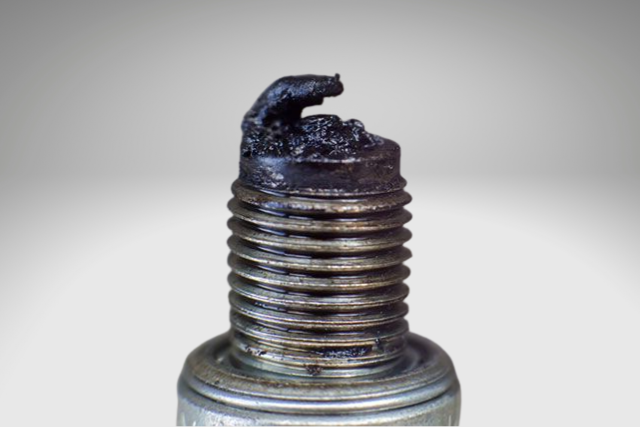
Oil-fouled spark plugs are one of the most common spark plugs you will see if your vehicle has seen some good distance in its time.
The spark plug tip looks wet, black, greasy, and shiny.
So, if the spark plug you are checking has black grease and is wet on the tip, you can be sure to say the spark plug is oil-fouled.
Now, what exactly is this oil fouling?
Oil fouling happens when the engine oil enters the combustion chamber, gets burnt, and deposits on the engine components. In this case, depositing on the spark plugs. This oil burnt deposit is when we say a component is oil fouled.
As for how the oil gets into the engine combustion chamber, here are the reasons:
- damaged piston rings
- worn-out valve seals
- low-quality engine oil
These are the main reasons leading to spark plug oil fouling.
Damaged and worn-out piston rings allow the oil to move from the crankcase to the combustion chamber. Valve seals stop ensuring no oil leakage when worn out. And poor quality engine oil with low viscosity can slip past the piston rings and enter the combustion chamber.
In two-stroke engines, the reason for oil fouling in spark plugs is the oil mixture being too rich. Two-stroke engines do not have separate chambers for oil and fuel mixture. The oil is added directly to the fuel, usually, in the fuel tank.
If the oil added to the fuel is too much, then the oil flowing in the engine will also get burned and start depositing on the spark plugs. The oil deposits are black, wet, and shiny. And that’s why you see the same on the spark plugs when oil fouled.
As for how to fix oil fouling, cleaning or replacing the spar plug is a must. Then check the piston rings, and valve seals for damage, and address it if necessary. Lastly, ensure that you are using high-quality engine oil.
To summarize:
Spark plug features: black and wet deposits; greasy and shiny.
Implication: Oil fouling.
Causes: damaged piston rings; worn-out valve seals; low-quality engine oil.
Solution: clean or replace the spark plug; check piston rings and valve seals for damage; use high-quality engine oil.
#2: Carbon Fouling
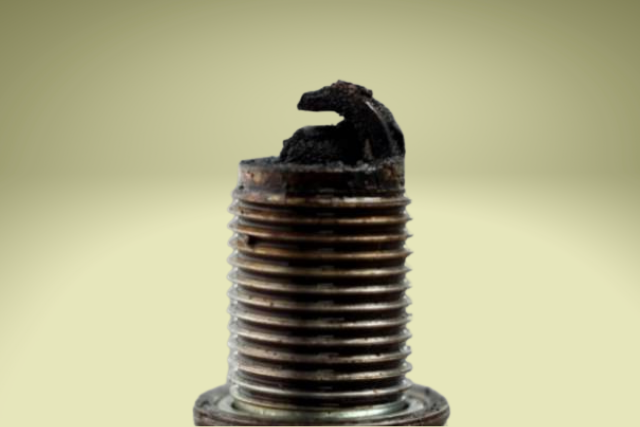
If the end of the spark plug is black, dry, and covered in soot – then the spark plug has carbon fouled.
The carbon buildup on the spark plug tip will be black in color and most importantly, dry (which separates this from oil fouling). if you touch the deposits, your will fingers will feel the soot with its powdery texture.
To reiterate, if the deposit is wet and slippery (but again in black texture), then that is oil fouling. On the other hand, if the black deposit is dry and sooty, then that is carbon fouling.
Now, that we know how to identify carbon fouling of spark plugs, let’s discuss its causes and solutions.
The primary cause for black carbon buildup on spark plugs is the engine burning a rich air-fuel mixture.
The rich air-fuel mixture results in the fuel not burning completely. And the unburnt fuel will start depositing on the spark plug leading to carbon buildup.
As for why the engine is running on a rich fuel mixture, these are the culprits:
- Carburetor tuning is off
- Air filter is clogged
The carburetor mixes air and fuel and then feeds the mixture into the engine. If the tuning is not right, the carb will mix the air and fuel in the wrong proportions – resulting in either a lean or a rich mixture.
The air filter, on the other hand, filters the air entering the carburetor. If it is clogged, not enough air enters the carb, thus again leading to a rich mixture.
Another reason for carbon buildup can be attributed to the spark plugs having a low heat range or a cold spark plug.
As for how to address carbon buildup in spark plugs, the immediate solution is of course to clean or replace the spark plug.
But, that will not prevent from the spark plug getting carbon buildup again. The root problems need to be addressed.
First, check the carburetor tuning and make sure it’s right. If not, tune the carb.
Second, ensure that the air filter is clean. If it is clogged too much, replace the air filter with a new one.
Third and last, if you are using a cold spark plug or a spark plug with a low heat range, consider changing to a spark plug with higher operating temperatures.
To summarize:
Spark plug features: black and dry deposits; covered in soot.
Implication: Carbon fouling.
Causes: the engine is running rich – carburetor tuning is off or the air filter is clogged; the spark plug has a low heat range.
Solution: clean or replace the spark plug; tune the carburetor and clean/replace the air filter; change the spark plug with a higher operating temperature.
#3: Ash Deposits
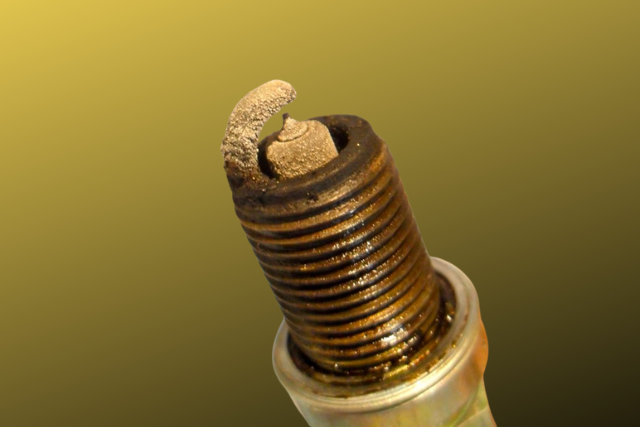
Ash deposits are formed when the engine oil is sucked in atomized form and burnt in the engine, forming white crusty deposits on spark plug electrodes.
The deposit might look very similar to that of carbon fouling. But, the major difference here is the ash deposits are white in color. As opposed to carbon fouling, where the carbon buildup is black in color.
In addition, the ash deposits are dry and have a sandy texture. Giving the white deposits a crusty look.
Another key thing to notice in ash deposits is that the deposits are primarily on the side (ground) electrode of the spark plug. This is another distinctive feature of ash deposits that can be used to identify them.
As for why ash deposits are formed on the spark plug – the main reason is the oil is sucked in atomized form and burnt to form these white deposits.
Now, how is it different from oil fouling? In oil fouling the amount of oil entering the engine is high. Not all oil is burnt and most are coating the spark plug thread.
Ash deposits, on the other hand, is burnt oil. The oil amount is not too much but enters the engine as tiny droplets. Most likely from damaged valve seals or valve guides. Not from damaged piston rings.
As for how to go about fixing the ash deposits, it’s not as laborious as oil fouling. You need to replace the spark plug of course. But there is no need to check the piston rings. Check for damages or wear on valve seals and guides. Address the if there are damages.
To summarize:
Spark plug features: white crusty deposits; dry and sandy in texture.
Implication: Ash deposits.
Causes: oil sucked in the atomized state – damaged valve seals or damaged valve guides.
Solution: clean or replace the spark plug; check valve guides and valve seals for damage.
#4: Worn Out
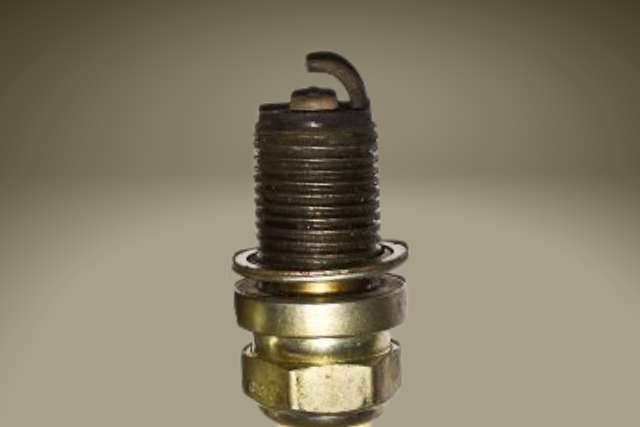
Worn-out spark plugs are nothing but spark plugs that have traveled too much distance. The spark plug has been used beyond its lifespan.
A typical spark plug usually has a lifespan of 10,000 miles (16,000 kilometers). Exceptions exist with different types of spark plugs built to last much longer.
Now how do you identify that the spark plug is worn out?
If you look at the center electrode and see that the center electrode is noticeably worn away, then the spark plug is worn out and needs to be replaced.
This is normal wear. There is nothing wrong with the engine and no engine component is damaged or malfunctioning.
It just means that the spark plug has been working for far too long a time and it’s time to be replaced. The spark plug has too many miles under its belt. Time to retire it.
The solution is, no surprise, you need to replace the worn-out spark plug with a new one.
It is also better to check the condition of the spark plug from time to time. You can ask the dealer or the service shop guy to check the spark plug every time you take your vehicle for servicing.
As a thumb rule, most motorcycle manufacturers recommend a periodic check of spark plugs every 4000 to 5000 miles of distance traveled. You can follow that. Or a periodic check along with the servicing works perfectly fine too.
To summarize:
Spark plug features: the center electrode is worn out; can be hardly seen.
Implication: Worn-out spark plug.
Causes: spark plug has too many miles under it.
Solution: replace the spark plug.
#5: Normal Condition Spark Plug
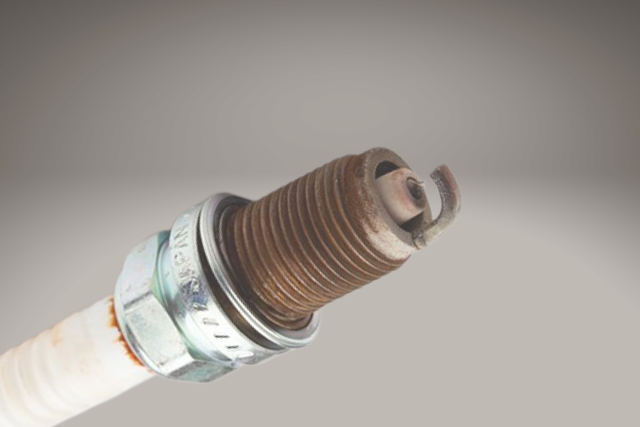
With so many deposits, different colors, and textures seen on the spark plugs, it can get confusing as to what a normal and a good functioning spark plug looks like.
Let’s check on that then.
If the used spark plug has a little bit of discoloration, is clean with no deposits, and the electrodes are worn slightly but evenly, then the spark plug is normal and is in good condition.
A normal spark plug that has run for decent miles will have slight discoloration on its tip and the threads. It won’t be sparkly clean (get it?).
While there will be some discoloration, you won’t see any deposits of any kind on the spark plug tip though. That’s one of the hallmarks of a good condition spark plug. It also signals that the engine is running smoothly and is in good condition.
Lastly, the electrodes – both the center and the ground electrode will be worn-out slightly. Depending on the distance traveled under this spark plug, the wear will be visible more and more with increasing miles.
To summarize:
Spark plug features: no deposits; slight discoloration; electrodes worn out slightly.
Implication: Normal and good condition spark plug.
Causes: nothing. The engine is running smoothly.
Solution: nothing again and not required. The spark plug is in good condition.
To Summarize
Here are the spark plug features and what it means.
- Black and wet deposits, greasy in texture: oil fouling.
- Black and dry deposits, sooty in texture: carbon fouling.
- White crusty deposits, dry and sandy in texture: ash deposits.
- Center electrode is worn out and can be hardly seen: a worn-out spark plug.
- No deposits, slight discoloration: the spark plug is in good condition.
